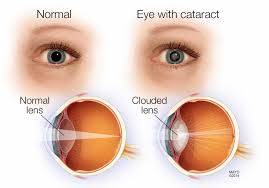A Clear Vision: Understanding and Preventing Cataracts
Introduction:
Cataracts are one of the most common eye conditions affecting millions of people worldwide. Characterized by clouding of the eye's natural lens, cataracts can significantly impair vision and quality of life if left untreated. While cataracts are primarily associated with aging, they can also develop due to various factors such as genetics, lifestyle choices, and environmental influences. However, the good news is that there are several preventive measures individuals can take to reduce their risk of developing cataracts and maintain clear vision throughout their lives.
Understanding Cataracts:
Before delving into preventive strategies, it's essential to understand what cataracts are and how they develop. The eye's lens, located behind the iris and pupil, plays a crucial role in focusing light onto the retina, allowing us to see clearly. Over time, the proteins in the lens can clump together, leading to clouding and opacity, which is characteristic of cataracts. This clouding progressively worsens, causing vision to become blurry, hazy, or faded, making it difficult to perform daily activities such as reading, driving, or recognizing faces.
Risk Factors for Cataracts:
While aging is the primary risk factor for cataracts, several other factors can increase the likelihood of developing this condition:
1. **UV Exposure**: Prolonged exposure to ultraviolet (UV) radiation from sunlight can accelerate the formation of cataracts. It's crucial to protect your eyes by wearing sunglasses that block both UVA and UVB rays, especially during peak sunlight hours.
2. **Smoking**: Smoking not only harms your lungs but also increases your risk of cataracts. Chemicals in tobacco smoke can damage the lens proteins, contributing to the development of cataracts. Quitting smoking or avoiding exposure to secondhand smoke can significantly lower your risk.
3. **Diabetes**: People with diabetes are at higher risk of developing cataracts due to elevated blood sugar levels that can damage the lens over time. Managing diabetes through medication, diet, and lifestyle changes is essential for preventing complications, including cataracts.
4. **Obesity**: Excess body weight, particularly abdominal obesity, has been linked to an increased risk of cataracts. Maintaining a healthy weight through balanced nutrition and regular exercise can help reduce this risk.
5. **Poor Nutrition**: A diet lacking in essential nutrients, particularly antioxidants such as vitamins C and E, lutein, zeaxanthin, and omega-3 fatty acids, may contribute to cataract formation. Consuming a variety of fruits, vegetables, whole grains, and lean proteins can provide the necessary nutrients to support eye health.
Preventive Strategies:
While some risk factors for cataracts, such as aging and genetics, are beyond our control, there are several proactive steps individuals can take to lower their risk and preserve their vision:
1. **Regular Eye Exams**: Routine eye examinations are crucial for early detection and treatment of cataracts. An eye doctor can detect signs of cataracts during a comprehensive eye exam and recommend appropriate interventions to manage the condition.
2. **UV Protection**: Invest in high-quality sunglasses that block 100% of UVA and UVB rays. Wear sunglasses outdoors, even on cloudy days, and choose wide-brimmed hats for added protection against harmful UV radiation.
3. **Healthy Diet**: Incorporate foods rich in antioxidants and essential nutrients into your diet to support eye health. Include colorful fruits and vegetables such as oranges, berries, carrots, spinach, and kale, as well as sources of omega-3 fatty acids like salmon, tuna, and walnuts.
4. **Quit Smoking**: If you smoke, take steps to quit smoking as soon as possible. Seek support from healthcare professionals, join smoking cessation programs, or explore nicotine replacement therapies to help you quit successfully.
5. **Manage Chronic Conditions**: If you have underlying health conditions such as diabetes or hypertension, work closely with your healthcare provider to manage these conditions effectively. Monitor your blood sugar levels, blood pressure, and cholesterol levels regularly to prevent complications that could affect your vision.
6. **Maintain a Healthy Weight**: Aim to achieve and maintain a healthy weight through a balanced diet and regular physical activity. Focus on consuming nutrient-dense foods and limiting processed foods, sugary snacks, and high-fat meals.
7. **Limit Alcohol Consumption**: Excessive alcohol consumption has been associated with an increased risk of cataracts. Limit your alcohol intake to moderate levels or avoid alcohol altogether to reduce your risk of developing cataracts.
8. **Protect Your Eyes**: Take precautions to prevent eye injuries, particularly when engaging in activities that pose a risk of trauma or impact. Wear protective eyewear when participating in sports, working with power tools, or engaging in activities where flying debris or chemicals may be present.
Conclusion:
Cataracts are a common age-related eye condition that can significantly impact vision and quality of life if left untreated. While certain risk factors for cataracts, such as aging and genetics, cannot be modified, there are several preventive strategies individuals can adopt to reduce their risk and maintain clear vision throughout their lives. By prioritizing eye health, adopting a healthy lifestyle, and seeking regular eye care, you can take proactive steps to safeguard your vision and enjoy a lifetime of clear sight. Remember, early detection and intervention are key to preserving eye health and preventing vision loss due to cataracts.


